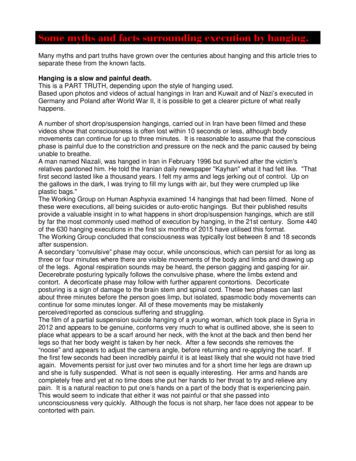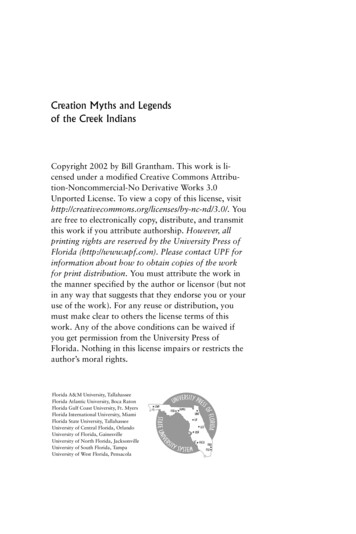
Transcription
Some myths and facts surrounding execution by hanging.Many myths and part truths have grown over the centuries about hanging and this article tries toseparate these from the known facts.Hanging is a slow and painful death.This is a PART TRUTH, depending upon the style of hanging used.Based upon photos and videos of actual hangings in Iran and Kuwait and of Nazi’s executed inGermany and Poland after World War II, it is possible to get a clearer picture of what reallyhappens.A number of short drop/suspension hangings, carried out in Iran have been filmed and thesevideos show that consciousness is often lost within 10 seconds or less, although bodymovements can continue for up to three minutes. It is reasonable to assume that the consciousphase is painful due to the constriction and pressure on the neck and the panic caused by beingunable to breathe.A man named Niazali, was hanged in Iran in February 1996 but survived after the victim'srelatives pardoned him. He told the Iranian daily newspaper "Kayhan" what it had felt like. "Thatfirst second lasted like a thousand years. I felt my arms and legs jerking out of control. Up onthe gallows in the dark, I was trying to fill my lungs with air, but they were crumpled up likeplastic bags."The Working Group on Human Asphyxia examined 14 hangings that had been filmed. None ofthese were executions, all being suicides or auto-erotic hangings. But their published resultsprovide a valuable insight in to what happens in short drop/suspension hangings, which are stillby far the most commonly used method of execution by hanging, in the 21st century. Some 440of the 630 hanging executions in the first six months of 2015 have utilised this format.The Working Group concluded that consciousness was typically lost between 8 and 18 secondsafter suspension.A secondary “convulsive” phase may occur, while unconscious, which can persist for as long asthree or four minutes where there are visible movements of the body and limbs and drawing upof the legs. Agonal respiration sounds may be heard, the person gagging and gasping for air.Decerebrate posturing typically follows the convulsive phase, where the limbs extend andcontort. A decorticate phase may follow with further apparent contortions. Decorticateposturing is a sign of damage to the brain stem and spinal cord. These two phases can lastabout three minutes before the person goes limp, but isolated, spasmodic body movements cancontinue for some minutes longer. All of these movements may be mistakenlyperceived/reported as conscious suffering and struggling.The film of a partial suspension suicide hanging of a young woman, which took place in Syria in2012 and appears to be genuine, conforms very much to what is outlined above, she is seen toplace what appears to be a scarf around her neck, with the knot at the back and then bend herlegs so that her body weight is taken by her neck. After a few seconds she removes the“noose” and appears to adjust the camera angle, before returning and re-applying the scarf. Ifthe first few seconds had been incredibly painful it is at least likely that she would not have triedagain. Movements persist for just over two minutes and for a short time her legs are drawn upand she is fully suspended. What is not seen is equally interesting. Her arms and hands arecompletely free and yet at no time does she put her hands to her throat to try and relieve anypain. It is a natural reaction to put one’s hands on a part of the body that is experiencing pain.This would seem to indicate that either it was not painful or that she passed intounconsciousness very quickly. Although the focus is not sharp, her face does not appear to becontorted with pain.
The short drop/suspension form of hanging develops far less force and thus causes far lessdamage to the structures of the neck. It is less likely to tear muscles and tendons than longerdrops might do.In executions the wrists are typically secured behind the prisoner’s back either by handcuffs orstraps so that arm movements are limited, although clearly visible in at least two of the filmedIranian hangings. Similarly the legs are normally strapped or shackled which limits theirmovement, although it is not at all uncommon for them to be drawn up, almost to a sittingposition, as is seen in this photo from a hanging in Tehran in June 2012.In properly carried out measured drop hangings where there is fracture/dislocation of the uppercervical vertebrae and severance of the spinal cord, there is usually no obvious/visible suffering.However countries such as the USA and Kuwait typically report the time of death, defined aswhen no heart beat can be found by listening with a stethoscope. It is not unusual to seereported times ranging from 10 to 20 minutes from when the trap door opens to when theattending physician pronounces death. These reports have a tendency to give the misleadingimpression that the person was conscious and suffering throughout the period. The reason theheart continues to beat is that it has a sinoatrial node. This is located in the upper wall of theright atrium and does not depend upon impulses from the brain. This is also referred to as theheart’s pacemaker and it generates nerve impulses that travel throughout the heart wall causingboth atria to contract. This action can maintain heart beat for up to 25 minutes until the build upof acidic carbon dioxide in the blood prevents further muscular function. A study of 53executions carried out on Nazi war criminals at Hameln in Germany by the British hangmanAlbert Pierrepoint found that 51 made no movement at all after the drop. In two cases therewas “slight contraction of the knees” and that audible heartbeat persisted for an average of 12minutes.Brain death is thought to occur within 5-6 minutes after suspension due to the stoppage of theoxygen supply to that organ and congestion caused by blood being unable to return via thejugular veins.Where hanging severs the spinal cord at or just below the level where it joins the brain stem(the medulla oblongata), unconsciousness is thought to be instantaneous. Where the spinalcord remains intact there is usually obvious physical suffering and visible struggling and this
may be more intense than in short drop hanging. The longer the drop distance the greater theacceleration of the body due to gravity and therefore the greater the damage done to thestructures of the neck. If the drop is extremely long the head will be torn off from the body ashappened in two instances in the USA, one in Britain and one in Kuwait. If the drop iscalculated correctly the neck will be broken and if it is not long enough the person will be slowlyasphyxiated, but will experience far more pain due to the force created on the muscles,ligaments and tissues of the neck by the insufficient, but still lengthy drop. Dr. W. A. Carte whogave evidence to the Aberdare Committee had witnessed long drop hangings where the neckwas not broken and stated that he had seen struggling persist for up to five minutes. Howeverhe thought that they were no longer conscious after a minute and a half. This was followed by aquiescent period of two minutes or so and then further involuntary/unconscious movements foranother two minutes.The Kuwait Times newspaper filmed the long drop hanging of two men on the 18th of June2013. Hajjaj Al-Saadi struggled hard for 45 seconds after the drop fell. He was a fitness fanaticand the drop proved inadequate. The second man, Ahmadi Abdulsalam, died without a struggleand his body relaxed and became limp within a few seconds. However both men took aroundthe same time (10 minutes) to be pronounced dead. The video of their executions is on theKuwait Times YouTube page. Warning it is real and it is graphic.Hanging causes instantaneous death.This is strictly speaking a MYTH, largely put about by the British government from around thebeginning of the 20th century until abolition to make executions seem more palatable to thegeneral public. At best hanging causes instant unconsciousness and immediate cessation ofbreathing, but as discussed above, as the heart is still beating for some time, death can neverbe truly instantaneous. American newspaper reports of early 20th century hangings wouldtypically state whether a person’s neck was broken together with how long it took them to die.In Britain this information was completely secret, but surely the reality had to be the same inboth countries. One thing that is clear is that the time taken for the heart to stop beating is veryvariable - anything from 3 to 25 minutes.Defecation and/or urination before and during hanging.This is a PART TRUTH. Sudden opening of the sphincters can be caused by an adrenaline rushand is not uncommon in situations of extreme fear, such as exists in executions. OlgaHepnarová, who became the last woman executed in Czechoslovakia, when she was hanged atPankrác prison Prague on March 12th, 1975, lost control of her bodily functions as she wasdragged kicking and screaming to the gallows, according to the famous Czech writer, BohumilHrabal, who had interviewed the Pankrác hangman some years later. The hangman went on tosay that the experience had traumatized him, and caused him to become totally disgusted withhis job.It has been claimed that George Kelly who was hanged at Liverpool on the 28th of March 1950,soiled himself on the way to the gallows.Defecation and/or urination can happen in any form of death (natural and un-natural) as themuscles finally relax at or about the point of death. These phenomena can occur in executionsby hanging as well as electrocution, gassing and lethal injection. However in most cases ofhanging they don’t and only three of the many legally taken high quality photos of hangings inIran (2 by short drop) and Kuwait (1 by long drop) show any sign of urination and none ofdefecation. It is possible that urination was more common at London’s Tyburn for two reasons.The journey from Newgate took two to three hours and there were two stops made for alcoholicrefreshments on the way. This gave rise to the vernacular phrase “pissing when you can’twhistle”.
Do male prisoners have an erection and ejaculate during hanging?One of three men hanged in Kuwait on 21/11/2006,showing evidence of urination.Above a man hanged in Sari Iran in August 2014,appears to have an erection, as does a man hanged inNaishpur in September 2016 (right) who was stillstruggling at the time.Lincoln conspirator, Lewis Payne appearsto have an erection.
In popular culture it has often been claimed that men have erections and ejaculate whenhanged. Some refer to this as “angel lust”.So do these things actually happen? The answer appears to be YES to both, but very rarely.Hanging where the spinal cord is severed.Although the person is unconscious, as stated earlier the heart continues to beat for anywherefrom 3 to 25 minutes. In Britain the law required prisoners to hang for one hour and thisremained in force up to 1957. Therefore cessation of heartbeat could have occurred anywherebetween 57 minutes and 35 minutes after the drop. When heart action ceases, the liquid bloodis only affected by gravity and having filled the vessels of the legs and arms, pools in theabdomen which could occasionally cause male prisoners to have penile erections (priapism).Similar engorgement of the labia has been observed in females. These effects are entirely postmortem and unconscious. In most other countries, particularly in modern times the body istaken down as soon as it has been certified dead thus reducing the possibility of priapism.In the handwritten autopsy notes of a British hanging (Patrick Mahon in 1924) the famouspathologist Sir Bernard Spillsbury noted that there was no priapism or seminal effusion butunderstood there to have been "a slight escape of urine". The body would have been strippednaked by the executioner prior to autopsy. No "seminal effusion" seems to imply that he hadfound this on occasion. Hand written notes of executions carried out in Melbourne Australianoted ejaculation on three occasions in the early 1900’s, although in each case death wasstated to have been “instantaneous”.Hanging where the spinal cord is not severed.The original photograph of the execution of the Lincoln conspirators in America in 1865 appearsto show one of the men, Lewis Payne (aka Powell), had an erection during his hanging, duringwhich he struggled violently. See photo above.Dr. Charles Croker King was a surgeon in Ireland in the mid 19th century and was able toexamine the body of John Hurley who was hanged on the 27th of August 1853 at Galway,immediately after the execution. Hurley’s neck was not broken by the drop. King noted that hispenis was erect and that there was a whitish liquid that had come from it. He took a slide of thisand examined it under a microscope, finding spermatozoa. This together with the other postmortem findings was reported on page 89 of his treatise “On Death by Hanging” published in1854. King was professor of anatomy and physiology at Queen’s College Galway and hiswritings are clearly those of a scholar rather than a tabloid journalist.An erection may be caused by the constriction of the carotid arteries and jugular veins,preventing blood flow to and from the head, combined with an elevated heart rate. Pressurisedblood can fill the corpora cavernosa of the penis causing erection.Ejaculation may be caused by the stimulation of the erect penis during the conscious andconvulsive phases, combined with the pressure on the Vagal (vagus) nerve which is responsiblefor sexual arousal, together with the reduced level of oxygen reaching the brain, as happens inautoerotic asphyxia.The analysis of public hangings in Iran shows what appears to be an erection in four instancesand possible ejaculation in just two cases. Below are photos of a man hanged for rape in Rabatin Iran in July 2012. Neither the bulge or the apparent damp spot were visible in earlier photosbut appear at or near death. In a 2015 case there is a clear damp spot of about 1 inch indiameter which is not present in earlier and equally clear photos.
The “pleasures of hanging”.In November 1885 the New York Times published an article under the above headline. TheBritish newspaper, the Pall Mall Gazette, that originally published the story, says that the personwho wrote of his experiences was a member of a suicide club. The hanging took place in abarn, where a “stout” rope had been tied to the rafters. The anonymous subject mounted achair and placed the noose around his neck, before his friends removed the chair. Hedescribes feeling a “great jerk”. In another moment he was transported into a new world whichhe described as being “more beautiful than anything imagined by the poets.” He further relates“swimming in a sea of oil” which was an “exquisitely delicious” feeling. He reported seeingbright colours and lights. He “swam” to shore and lay on the beach but when he opened hiseyes he saw his friends peering at him. After he was taken down he felt pain in his neck andweakness, but still insisted that the experience had been pleasurable. His friends, who hadwitnessed his convulsions and “struggles” were not convinced. I cannot verify this as FACT orMYTH, but it is at least somewhat credible.
The myth of the mandrake plant.There is a famous MYTH surrounding ejaculation and the mandrake plant, which is said to growunder the gallows where a man has ejaculated. The 1985 film “Flesh & Blood”, supposedly setin the year 1501, has a scene where the main characters come across the corpses of twohanging men. Steven tells Agnes that men ejaculate when hanged and where their semen fallsa mandrake plant grows. Agnes has read about the magic powers of the mandrake and digs upthe root beneath one of the corpses, saying that if they each eat part of it, they will love eachother forever. Romantic, perhaps, but there doesn’t appear to be any truth in this.Eyes bulging out of their sockets and other facial disfigurement.This seems to be largely a MYTH. Rather than relying on apocryphal anecdotes I would preferto rely upon the analysis of public hangings in Iran, mentioned above. This shows obviousphysical struggling in 10 cases, the tongue protruding slightly in four cases, no obviousreddening of the face in any case, drooling from the mouth in two cases and no instances ofeyes bulging out of their sockets. In most cases the faces looked peaceful in death, as wasoften reported at British hangings when the press were allowed to see the body at inquest. Allof the Iranian prisoners were hanged using coiled nooses with the knot placed at the back of theneck, thus putting maximum pressure on the base of the tongue, (hence it protruding in somecases) and on the carotid arteries and jugular veins. Typically the prisoner is left on the rope for20 minutes in Iran.Can a person survive hanging?Again the answer is YES, but only very rarely. Hanging when carried out with little or no dropdoes not cause instant death, neither does it cause severe physical damage to the neck, butrather squeezes the life out of the person over a period of time due to constriction of the neckcausing pressure on the carotid arteries ,jugular veins and Vagal nerve and pressure on thetrachea (windpipe). Respiration does not stop either automatically or totally but rather reducesover time. Pressure on the carotid artery may cause a reflex which slows the heart and mayeventually stop it. The vertebrae protect the vertebral and spinal arteries which also supplyblood to the brain and thus the brain, in what is a virtually comatose state, does not necessarilybecome totally starved of oxygen. It is notable that in none of the cases examined below didthe person exhibit signs of obvious brain damage after their recovery.On the 8th of May 2013, Vahid Zare was hanged in public in Mashad, Iran. He had murdered ayoung soldier and the victim’s family witnessed the hanging. As normal, little drop was given.Zare struggled violently for some seconds after the chair was removed from under him. After hehad been suspended for 59 seconds the victims’ father decided to pardon him, as is permittedunder Islamic Sharia law. Officials immediately supported Zare while the noose was removedand he could be taken down. He was given oxygen at the scene and taken to hospital where itseems that he recovered quite quickly. Sadly his thoughts on the ordeal were not recorded.The photos below tell the story.
Another case of survival occurred in Iran on the 9th of October 2013. A prisoner was found tobe alive 24 hours after being hanged and declared dead. According to the official website of theIranian State Broadcasting Jam-e-Jam Online, a 37 year old man identified as "Alireza M." washanged in the prison of Bojnord (north-eastern Iran), having been convicted of possession of 1kilogram of crystal meth.The hanging lasted for 12 minutes, before a doctor confirmed his death, the death certificatewas signed by the judge and other officials present and his body was transferred to the coldroom.The day after (October 10th) when the cold room staff came to remove the body they realizedthat he was still breathing. He was transferred to hospital and his condition was reported assatisfactory by October the 15th.In Britain prior to around 1750 the practice of leaving the person on the rope for one hour hadnot been instituted and they were taken down when the officials thought they were dead.There are a number of reliable cases where a person was revived after an apparently normalexecution. See the “Half Hanged” page of this site for descriptions and analysis of these casesWould a person be hanged twice or were they automatically reprieved if the rope brokeor the gallows mechanism failed?YES they would, both in Britain and the USA. Unlike those who were actually hanged untilapparently dead, this unfortunate class of prisoners were normally hanged again. It was notunknown in Britain prior to 1888, when the hangman supplied the rope for it to break and for theprisoner to fall through the trap doors onto the ground below. Normally they didn’t sustainserious injury from this and were bought back up and hanged again using a new rope, often to
the disgust of the crowd. However it was the law and in accordance with their sentence, thatthey be hanged by the neck until they were dead.An example of this was Staffordshire’s last public hanging which took place on the gatehouseroof of Stafford Gaol on the 7th of August 1866. 35 year old William Collier was to die for themurder of gamekeeper Thomas Smith. Hangman George Smith from Dudley used the samerope that had been used for Staffordshire’s previous execution. When he released the trap thesplice in the rope gave, causing it to slip from the chain and Collier plunged down inside the boxlike structure of Stafford’s gallows. A new rope was brought out and the execution repeated,this time successfully. Smith was booed and hissed by the crowd of 2,000.John Lee is the only case I am aware of where the prisoner survived thee attempts to hang himand was reprieved. Twenty year old John Henry George Lee was convicted of the murder of hiselderly employer Emma Anne Whitehead Keyse, for whom he worked as a footman at “TheGlen” in the village of Babacombe in Devon. On Saturday the 15th of November 1884, Emma’sbody was discovered in the dining room. Her throat had been cut, she had head injuries and anattempt had been made to burn her body, the house having been set on fire with paraffin inthree different places. Only one man was in the house at the time of the murder, John Lee, thefootman. Lee had a cut on his arm which he claimed to have done breaking a window to allowsmoke to escape. The paraffin can which had been full the day before and was stored in Lee’spantry, it being one of his duties to top up the lamps with it, was found to be empty. He wasarrested and charged with his employer’s murder, coming to trial before Sir Henry Manisty atthe next Devon Assizes where he continued to protest his innocence. He was convicted oncircumstantial evidence and sentenced to death. The execution was set for Monday the 23rd ofFebruary 1885 at Exeter prison and James Berry was appointed to carry it out. The gallowswas set up in the coach house of the prison, that normally housed the prison van. Lee was ledin just before 8 a.m. and the usual preparations made, but when Berry pulled the lever, virtuallynothing happened, the trap doors just dropping an inch or so. Berry stamped on them and triedthe lever again but to no avail. So the hood, noose and straps were removed and Lee was thentaken back to his cell whilst the trap release mechanism was checked and re-tested. It workedperfectly.The process was now repeated but with the same result and yet again the trap worked as soonas Lee was removed. After the third unsuccessful attempt, the governor took the decision to haltthe execution whilst he obtained directions from the Home Office. Lee’s death sentence waslater commuted to life in prison by the Home Secretary, Sir William Harcourt, and he served 22years before released from Portland Prison in 1907. He became known as "The man they couldnot hang" and the case received wide spread publicity.Conspiracy theories abounded as to why the trap would not open with Lee on it, ranging fromdivine intervention, through the wood swelling in the damp weather, to one of the prisoners whohad helped to erect it placing a wedge between the leaves of the trap which he removed againas soon as Lee was taken off and reinserted at each new attempt. The reality was much moreprosaic. The gallows had last been used in a different location in the prison for the hanging ofAnnie Tooke in 1879. When it was erected in the coach house the frame was not been installedcorrectly and one of the long hinges fouled on the drawbar when there was weight on thetrapdoors but not when there wasn’t. When the lever was pushed and the drawbar slid alonguntil the cranks lined up with the 2 hinge ends, one hinge end dropped through but the otherremained resting on the crank by one-eighth of an inch. So the doors moved slightly (twisting alittle as one end dropped and the other didn't) but then held firm.Ghosts of the hanged.Most hanging prisons seem to have at least one ghost, according to paranormalists and often tothe staff as well.
Unsurprisingly, given the number of hangings there, London’s Newgate prison was said to behaunted by several ghosts. Footsteps were reported along Dead Man's Walk at night, onewarder reported seeing the face of a hanged man in a cell. An aging female form was also saidto have been seen in one of the yards. The Old Derby Gaol and Bodmin Gaol are both claimedto be haunted. On a visit to Derby I was given quite a lot of detail on its ghosts. One of themoccasionally pushes bottles and glasses off the bar. Gordon Trenoweth is said to haunt ExeterPrison. Trenoweth was the last person to be hanged there on the 6th of April 1943.The old State Penitentiary in Boise Idaho claims to be haunted by the ghost of RaymondSnowden who was the last man to be hanged there on the 18th of October 1957. Snowdenstruggled hard after the drop fell and did not have an easy death.Personally I neither wholly believe or disbelieve in ghosts. If one accepts that electrical energycannot be destroyed, where does the electrical energy within the brain dissipate to? Normally itwould be to the ground (electrical earth). Hanging is an unusual form of death in so far as theperson is suspended in mid air by a rope, and is therefore electrically insulated. So there isnowhere for the electrical energy to go to until the body is taken down and laid on the groundwhich was typically an hour later. So MYTH or FACT? I leave this one to you.Touching a hanged person cures warts and cysts or wens, as cysts were known.Prior to the abolition of public hanging in Britain in 1868 it was not unusual for people sufferingfrom warts and wens to attend an execution and pay the hangman to rub the executedcriminal’s hand on the affected part. It was believed that the affliction would transfer itself to thedead criminal.The Gentleman’s Magazine reported that at the hanging of murderer Francis Gorman at Tyburnon Monday the 4th of March 1767 "a young woman, with a wen upon her neck, was lifted upwhile he was hanging, and had the wen rubbed with the dead man’s hand, from a superstitiousnotion that it would effect a cure." 10 years later at the hanging of Dr. Dodd at Tyburn on the27th of June 1777 a newspaper reported that "After he had hung about ten minutes, a verydecently dressed young woman went up to the gallows, in order to have a wen in her facestroked by the Doctor's hand, it being a received opinion among the vulgar that it is certain curefor such a disorder. The executioner, having untied the doctor's hand, stroked the part affectedseveral times therewith". Unsurprisingly there is no record of any actual cure being effected!So this one appears to be a MYTH.
The film of a partial suspension suicide hanging of a young woman, which took place in Syria in 2012 and appears to be genuine, conforms very much to what is outlined above, she is seen to place what appears to be a scarf around her neck, with the knot at the back and then be










